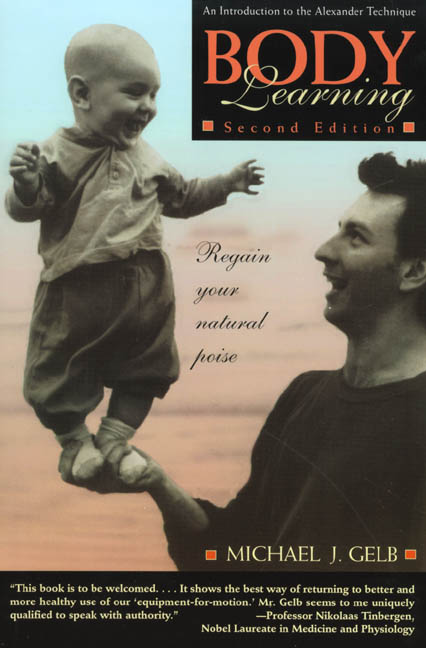 By Daniel Singer and Jessica Santascoy
Daniel Singer, an Alexander Technique teacher at the American Center for the Alexander Technique with over 30 years of experience, tells us why he recommends Michael Gelb’s "Body Learning," and gives us a couple of questions from the book to ask yourself about habits.
By Daniel Singer and Jessica Santascoy
Daniel Singer, an Alexander Technique teacher at the American Center for the Alexander Technique with over 30 years of experience, tells us why he recommends Michael Gelb’s "Body Learning," and gives us a couple of questions from the book to ask yourself about habits.
SANTASCOY
Which book on the Alexander Technique do you recommend for new students?
SINGER
The book that consistently meets my need for clear presentation of the Alexander Technique (AT) and that I recommend is "Body Learning" by Michael Gelb. The book is a valuable resource for people taking AT lessons, those who want to take lessons, and interested readers who like ideas as the basis for practical change.
SANTASCOY
Why do you recommend Body Learning?
SINGER
Body Learning lays out the Alexander Technique principles in a lively context that I find particularly enriching for a new student. The book sticks closely to almost all of the original ideas presented by F.M. While exceedingly careful not to water-down or dumb-down any important concepts or history for the convenience of the reader, Michael Gelb does a superb job of presenting concepts fairly succinctly and completely. He doesn’t insulate the reader from details about the ideas. Yet, he doesn’t overburden the reader, either. He takes them into the history of the Alexander Technique quite fully in a way that might bring some gravitas and intellectual interest to the reader.
The book is an overview and somewhat of a practical guide for the person interested in answering the question “What is the Alexander Technique and how can it help me?” The book helps answer that question, by anchoring the student in concepts such as Use and Functioning, The Whole Person, Primary Control, Unreliable Sensory Appreciation, Inhibition, Direction, Ends and Means.
Peppered with invaluable photos such as the Nuba tribespeople, the pianist Arthur Rubinstein, cats, and a student learning to write hunched over a desk, the book speaks to the holism and humanism of the AT work, by way of multiple, visual examples. At the same time, the photos sustain curiosity and illustrate concepts.
Michael provides "Checkpoints" at the end of every chapter, encouraging the reader to apply AT ideas to everyday life:
"Are you aware of your habits of moving, thinking and feeling? Try listing three habits of body use, thought, or emotion. (34)"
"Do you ever catch yourself responding habitually but find that you can't seem to change? (67)"
While presenting the intellectual and practical basis for Alexander’s unique ideas, Michael brings in personal anecdotes and stories by other teachers, which students can often relate to. He discusses matters such as "Learning How to Learn” and “What can I do myself” at the end of the book, just enough to inform and tantalize a reader about the importance of linking any interest in these ideas with Alexander lessons.
SANTASCOY
How have your students used to Body Learning to enhance lessons?
SINGER
A few months ago, upon my recommendation, a new AT student of mine (a graduate student in History), who obviously likes to read, got hold of Body Learning and read it. When she came in for her lesson the next week, she was surprisingly burning with interest to understand inhibition more deeply. She really got that fire more from Michael, than from me. His presentation simply clicked for her with additional “umpf." I had explained inhibition and referenced it in each lesson, repeatedly. But somehow Michael’s chapter on inhibition got to her in a way that I could not.
Presenting ideas is not always simple if they are to be presented with a reference to history and supporting evidence, and I am eternally grateful to Michael Gelb for having taken on that task and accomplishing it in a concise way. Bravo, Michael.
[author] [author_image timthumb='on']http://www.acatnyc.org/main/wp-content/uploads/2011/12/Daniel-Singer.jpg[/author_image] [author_info]DANIEL SINGER has over 30 years of experience teaching the Alexander Technique and is a senior teacher at the American Center for the Alexander Technique (ACAT). Graduating from the State University of New York at Buffalo, he then certified to teach the Alexander Technique and pursued post-graduate Alexander studies in London. Daniel teaches at Michael Howard Studios and is author of the book "The Sacred Portable Now" and co-producer of “The Back Alive Advantage” a self-lesson CD based on the principles of the Alexander Technique. Daniel has a private teaching practice in Manhattan. Connect with Daniel via email DSingerNY@aol.com or by phone at (917) 326-0493. [/author_info] [/author]
[author] [author_image timthumb='on']http://www.acatnyc.org/main/wp-content/uploads/2014/02/santascoy.jpg[/author_image] [author_info]JESSICA SANTASCOY is an Alexander Technique teacher specializing in the change of inefficient habitual thought and movement patterns to lessen pain, stress, anxiety, and stage fright. She effectively employs a calm and gentle approach, understanding how fear and pain short circuit the body and productivity. Her clients include high level executives, software engineers, designers, and actors. Jessica graduated from the American Center for the Alexander Technique, holds a BA in Psychology, and an MA in Media Studies. She teaches in New York City and San Francisco. Connect with Jessica via email or on Twitter @jessicasuzette.[/author_info] [/author]
